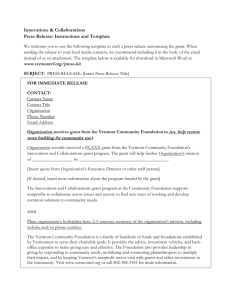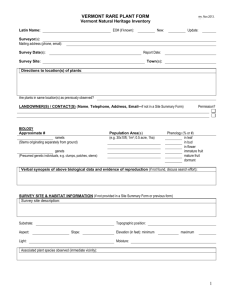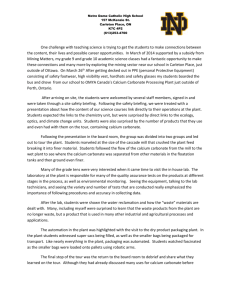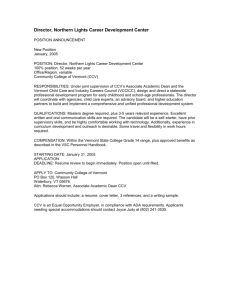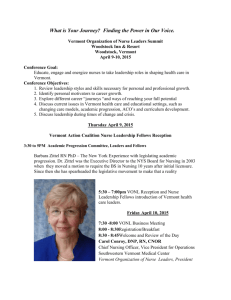Calcium Carbonate Mining in Vermont: Real Costs and Real Benefits
advertisement
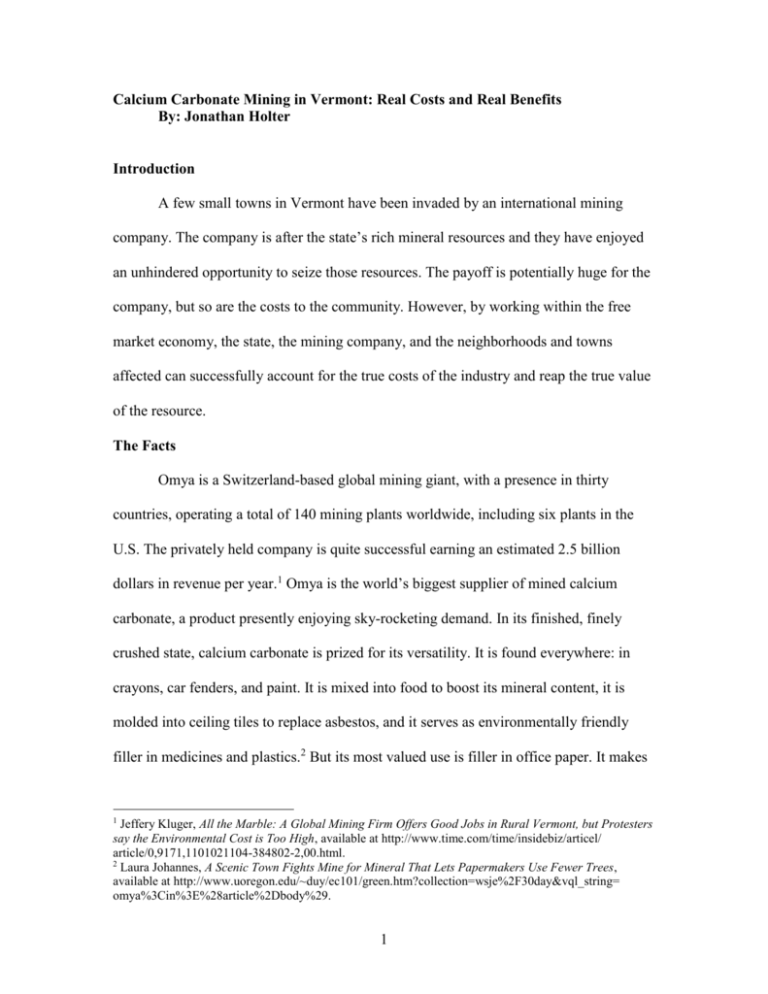
Calcium Carbonate Mining in Vermont: Real Costs and Real Benefits By: Jonathan Holter Introduction A few small towns in Vermont have been invaded by an international mining company. The company is after the state’s rich mineral resources and they have enjoyed an unhindered opportunity to seize those resources. The payoff is potentially huge for the company, but so are the costs to the community. However, by working within the free market economy, the state, the mining company, and the neighborhoods and towns affected can successfully account for the true costs of the industry and reap the true value of the resource. The Facts Omya is a Switzerland-based global mining giant, with a presence in thirty countries, operating a total of 140 mining plants worldwide, including six plants in the U.S. The privately held company is quite successful earning an estimated 2.5 billion dollars in revenue per year.1 Omya is the world’s biggest supplier of mined calcium carbonate, a product presently enjoying sky-rocketing demand. In its finished, finely crushed state, calcium carbonate is prized for its versatility. It is found everywhere: in crayons, car fenders, and paint. It is mixed into food to boost its mineral content, it is molded into ceiling tiles to replace asbestos, and it serves as environmentally friendly filler in medicines and plastics.2 But its most valued use is filler in office paper. It makes 1 Jeffery Kluger, All the Marble: A Global Mining Firm Offers Good Jobs in Rural Vermont, but Protesters say the Environmental Cost is Too High, available at http://www.time.com/time/insidebiz/articel/ article/0,9171,1101021104-384802-2,00.html. 2 Laura Johannes, A Scenic Town Fights Mine for Mineral That Lets Papermakers Use Fewer Trees, available at http://www.uoregon.edu/~duy/ec101/green.htm?collection=wsje%2F30day&vql_string= omya%3Cin%3E%28article%2Dbody%29. 1 for a brighter, more durable paper, and it reduces costs for the paper industry by decreasing the need to use wood pulp fillers. Today typical copy paper consists of 20% calcium carbonate.3 As we deplete more of our timber stands this number is expected to increase. For use in paper, the calcium carbonate must be pure and bright white, in short supply just about everywhere except Vermont. Vermont sits on an abundant and relatively easily accessible supply of 98% pure calcium carbonate mineral; the vein runs north to south, from Canada to Massachusetts.4 There are significant deposits sprinkled throughout the state: Middlebury, Salisbury, Brandon, Pittsford, South Wallingford, Danby, and Dorset. With intentions of profiting on Vermont’s good fortune, Omya has quietly purchased property in more than twenty area towns and now operates three mines and one processing plant statewide. The process Omya uses to mine the calcium carbonate in Vermont is typical of most mining operations: it involves an environmentally intensive procedure. First, marble is quarried in Middlebury and South Wallingford. Omya then loads the material into forty-ton trucks and hauls the raw ore down the back roads of Vermont to its Florence plant, where it is “processed.” The processing involves more than merely crushing the marble into dust. After a coarse grinding of the rock, mineral impurities are floated out of the slurry using a chemical flotation agent known as tall oil. The wash water and impurities are pumped outside the plant and into a series of unlined settling cells and former quarries. The settled solids are dredged and deposited in old quarries and in stockpiles on site. Another use of chemicals at the plant includes the addition of biocides 3 4 Id. Available at http://www.vtce.org/understandingomy.html. 2 to the finished slurry product. The plant produces various grades of dry powder, wet slurry, and treated products.5 From the mining of the raw material to the production of the final product the process is complex and environmentally involved. Omya claims the process is harmless: “Calcium carbonate is probably the most environmentally benign mineral you can put into anything. And the process of making it is just grinding. There’s no chemical reactions we’re doing, it’s a benign process in the manufacturing.”6 The comment is half true. While the finished product calcium carbonate is harmless enough to be used in food and everyday consumer products, the processing of calcium carbonate uses harsh chemicals, produces large amounts of waste, creates excessive noise, and generates a long list of externalities shoved upon neighboring communities to rectify. The externalities produced are significant. For example, from 1995 to 1999 Omya was the largest user of pesticides in Vermont, using three million pounds of active ingredient poison to kill bacteria in their product.7 Omya has repeatedly suffered spills of these and other chemical agents into local creeks and watersheds.8 In addition to heavy use of pesticides and bleach, the process of calcium carbonate mining involves dynamite blasting. “I live 1,100 feet from a quarry, walls rattle; it’s a real problem,” says Bill Church, a machinist at the local General Electric plant. The mines produce a very fine airborne dust which settles on neighboring houses, gardens, schools, and even finds its way inside air-conditioned houses in the summer. Omya mines rely on heavy use of Lauren Aldrich et. al., It’s Not Just Dirt: Permitting the Storage of Omya, Inc. Mine Waste in Florence, VT (Middlebury College service learning project for Environmental Studies Senior Seminar) 2003 at 3. 6 Annette Smith, Omya: The Truth, and the Public’s Right to Know, available at http://www.vtce.org/truth. html. 7 Id. 8 Available at http://www.vtce.org/omyarpt.pdf. 5 3 aquifers which feed local wells. In just one monitoring study prior to even beginning the mining process to see if the site was suitable for mining, a single aquifer was lowered 126 feet.9 The mining process involves drilling extensive shafts to reach the extensive marble deposits, potentially mingling wastewater with drinking water sources, or drying up wells altogether. The two-lane rural roads and the communities on them are subjected to the increased traffic and congestion created by forty-ton dump trucks making trips to and from Omya’s sites.10 The production of calcium carbonate produces tons upon tons of waste, chemically active toxic tailings piled up at Omya’s sites that threaten the health and welfare of the surrounding communities.11 Finally, there are aesthetic issues. The mining process results in massive pockmarks in the landscape of some of Vermont’s most unspoiled communities. Ultimately what Omya does is reduce the overall quality of life for those unfortunate enough to live near one its operations. In the name of jobs and economic development, a multi-national corporation is allowed to plunder the heart and soul of Vermont, laying waste to the some of the state’s most beautiful valleys, robbing the state of its common resources, and subjecting local residents to these costs of doing business. For an in-depth account of life in one of the towns neighboring Omya, see the Appendix. The Reasons Why Omya operates in the manner that it does because the operation of the modern capitalist free market system is fundamentally flawed. Neo-classical economics fails the neighbors of Omya by assuming an inexhaustible ability of the ecosystem to produce 9 Smith. Kluger. 11 What’s In Omya’s Waste? The Latest News From Vermonters for a Clean Environment (Vermonters for a Clean Environment, Inc., Danby, VT), Summer 2004. 10 4 resources and absorb waste. Omya’s profits are removed from Vermont while the true costs of business, externalities, are shifted upon the victims of the harm. Residents are failed by the neo-classical economist’s blind faith in the capacity of the market to respond to real human needs. The growth-oriented model of the economy, with its over-emphasis on GDP as the ultimate measure of wealth and happiness, fails to recognize the declining quality of life for those who live in towns and communities affected by Omya’s economic growth. The modern economic system fails the neighbors of Omya in not placing enough value in the pure public goods of clean air, clean water, and clean land. Instead, the State of Vermont values the bottom line contribution to the state’s GDP the multi-national corporation Omya delivers more than it values the quality of life of those Vermont residents unfortunate enough to be Omya’s neighbors. The neighbors of Omya are victims of a failed economic modus operandi that allows and encourages the type of behavior Omya engages in. Omya is conducting a full-scale assault on the commons. Vermont is fortunate to have been blessed with an abundance of mineral wealth. The fruits of this blessing should be shared among residents, present and future alike. Entrusting the commons under the watchful eye of the free market, as Adam Smith implored, has failed miserably. Companies like Omya are attempting to take as much of Vermont’s common assets as quickly as possible for private profit. Smith, in The Wealth of Nations, surmised that through unhindered self-interest the public interest is best served. But as Garrett Hardin, with the benefit of hindsight, pointed out in “The Tragedy of the Commons,” individual self-interest leads one to rationally take the biggest available piece of the commons.12 12 Garret Hardin, The Tragedy of the Commons, in Valuing the Earth: Economics, Ecology, Ethics 130-131 (Herman E. Daly and Kenneth N. Townsend eds.,1996). 5 The rational herdsman concludes that the only sensible course for him to pursue is to add another animal to his herd. And another, and another….But this is the conclusion reached by each and every rational herdsman sharing the commons.13 As Omya acts out of naked self-interest, as it can be expected to and is encouraged to do as a good neo-classical economic citizen, it contributes to the decimation of Vermont’s common resources. Omya can be anticipated, in our present mismanaged system, to act out of selfinterest and grab as big a chunk of Vermont’s mineral resources as they are able. But the state also fails Vermont citizens as well. The state stands by and allows corporate Omya to profit from plundering the state’s commons, while ordinary citizens are neglected. Omya’s state approved exploitation of the state’s natural resources removes money from the public purse that could be spent to benefit the public. In addition, it threatens Vermont’s environment by favoring short-term economic gain over long-term stewardship.14 The give away of Vermont’s common resources undermines the state’s long-term economic and social welfare. Conventional economics assumes that externalities are minor and inconsequential. Markets do not even recognize the costs of externalities.15 As Omya pollutes its community, tainting water supplies and sullying fresh air, it owes nothing for the harm caused. An industry, such as Omya, freely reaches into the never ending deposit of resources and extracts what it needs, transforms the resource into a finished product, and then discards what is left over into the limitless sink that is the ecosystem. If and when 13 Id. at 132. Peter Barnes, Who Owns the Sky: Our Common Assets and the Future of Capitalism, Island Press 7 (2001). 15 Id. at 7. 14 6 the ecosystem can no longer physically support Omya’s mining operations, global Omya picks up and moves to another state or country. Omya’s economic benefit registers large on the GDP scale of wealth: 2.5 billion dollars in revenue. Unfortunately, it is concentrated in the hands of well-paid executives and far away in private hands in Europe.16 For Vermonters the economic benefits are slim: a handful of unhealthy mining jobs and whatever state taxes Omya has to pay. By now the cost of Omya’s numerous externalities to the state most likely outweigh the accompanying economic benefits. The positive wealth created may actually be less than the negative costs associated with this wealth creation.17 On the other hand, the positive wealth creation can never outweigh the harm brought by Omya. The value of the negative affects is truly virtually infinite. Though there are various methods for valuing ecosystem services,18 it is impossible to price fresh and clean air, pure Vermont water, and the simple rural life that Vermonters enjoy. Ironically, GDP will actually account for the costs of externalities in a backdoor way; it will include the price residents pay for doctor’s visits due to respiratory illnesses and the price residents will be forced to pay for bottled water once wells are contaminated. GDP fails as a measure of welfare. Likewise, conventional economics has failed to truly account for the actual costs of externalities. Neo-classical economists see the economy as a small and ever-growing subsystem of a barely acknowledged but assumed to be vast and boundless world. An ecosystem that has an infinite ability to produce and absorb need not be cared after. Any recognition of a finite planet by the neo-classical economists is tempered by a belief that the market, 16 Kluger. Id. at 89. 18 Herman E. Daly and Joshua Farley, Ecological Economics: Principles and Applications, Island Press 407 (2004). 17 7 left to its own devices, will avert impending disaster via the fundamental forces of supply and demand. Elementary thermodynamics refutes this core tenet of conventional economics. After raw materials are used by the economic system they are returned to the environment as high entropy waste. Though the environment can assimilate a great deal waste, eventually a limit is reached. Waste builds up, threatening human well-being, affecting the ecosystem’s ability to handle future waste, and disrupting other crucial ecosystem functions. Waste absorption capacity is a sink for which we have control over the flow from the faucet, but not the size of the drain.19 The finite nature of our planet, its sources and sinks, has yet to be recognized by neoclassical economists. Solutions Any realistic remedy to the problems generated by Omya must embrace the free market. By harnessing the power of the free market to achieve environmental goals, conflict between economic development and environmental protection can be minimized. One solution to the problem embraces the power of the free market by pricing and valuing non-market goods and services. This solution is the “silver bullet” of many, a way to bring everything, the sky, the water, and the entire commons, within the free market and thus maintain our faith in the invisible hand. The market will never recognize the “intrinsic value” of the sky, but it will recognize the basic forces of supply and demand. As former CEO of Dow Chemical and captain of industry Frank Popoff expressed: Air, water, and land are not the “free good” our society once believed. They must be redefined as assets, so that they can be efficiently and appropriately allocated.20 19 Daly, 107. 8 According to this method, if mechanisms can be developed for internalizing all external costs and valuing all non-market goods and services, the market alone will lead to efficient allocation of these goods and services. Using one of the various pricing methods,21 a value is assessed and attached to the ecosystem services affected by Omya’s mining plants. Neighbors of Omya who are willing and able to pay for clean air and clean water will. “Supply and demand will find an equilibrium.”22 Others have problems with pricing the gifts of Mother Nature. The method of pricing is disparaged as expensive, centralized, and too reliant on the government. Critics point out that no clear, agreed upon method exists for calculating an ecosystem’s value; even experts struggle to quantify the total value of ecosystems. While these critics disagree with affixing a specified price to non-market goods, a process denigrated as “economic imperialism,” they do recognize the importance of identifying an inherent value to these goods. “We should act on our knowledge that zero is the incorrect price, and spend our time trying to improve upon and implement policies that recognize they have a significant, often infinite value, even if we cannot precisely quantify it.”23 I believe the answer may be somewhere in the middle. Reducing our infinitely valuable resources to a number appears crass, yet to slow the theft of our commons we will have to work within the market. The battle will be over methodology used to value ecosystem services. The challenge will be to the defenders of the commons, environmentalists and citizen’s groups, to organize and counterbalance the power of corporate interests who hold unprecedented sway over our government. Inevitably, 20 Barnes, 33. Daly, 407. 22 Barnes, 34. 23 Daly, 411. 21 9 industry will push for a lower value and environmentalists will push for higher values. In the end neither side will be satisfied. “Pay for what you take, not for what you make.” “Tax ‘bads’ not ‘goods.’” “Tax waste not work.”24 The most promising solutions to the shortcomings of neo-classical economics as represented by Omya in Vermont work within the free market, but they alter the basic economic incentives the system offers. Taxes and subsidies on use of sources and sinks can create economic incentives for industry to tread lightly. The answer is to internalize external costs. Omya should pay the full cost of the damage wrought by its mining process: house rattling noise, garden coating dust, and well contaminating toxic waste. Omya undertook the activity that gave rise to these costs; logically they should pay for the costs. Known as a “Pigouvian tax” this mechanism would add the external cost to the internal cost, accurately reflecting the true social cost of industry.25 Having to pay for externalities would naturally prompt industry to pollute less. The tax would not just punish industry. In fact, the tax would be passed on to the consumer. Forced to pay a higher price for goods manufactured by pollution, consumers will demand less of these goods. The internalization of industry’s externalities is both equitable and socially and economically efficient. Quantifying externalities may prove to be a challenge. Experts, environmentalists, and industry cannot agree on the true worth of the environment; they cannot be expected 24 Gary Flomenhoft, Progress and Poverty, power-point presentation, available at http://www.uvm.edu/~ gflomenh/VTLAW-EcoEcon/powerpoints5-commons-corruption/Progress&poverty.ppt 25 Herman E.Daly and John B. Cobb, Jr., For the Common Good: Redirecting the Economy Toward Community, the Environment, and a Sustainable Future, Beacon Press 55 (1994). 10 to agree on the value of externalities. The answer is to keep the valuation simple and straightforward. If Omya taints a water supply, they are forced to charge a higher price for calcium carbonate to fully cover the cost of bottled water for those whose water supply is ruined. If Omya ruins a garden or unsettles the foundation of a house, that cost is reflected in the final cost of the product. The tax Omya pays is equivalent to the real world damage caused by their industry. The true cost to Vermont, its citizens, and future citizens of losing a valuable mineral resource should be included as an externality, to be internalized via a Pigouvian Tax/stakeholder trust combination. Vermont should reclaim ownership of its commons. Added to the tax on Omya for polluting the air and water of Vermont should be a Vermont Commons User Tax. For every bit of Vermont calcium carbonate Omya digs out of the ground, money is paid into a trust. The Alaska Permanent Fund provides a successful model of how such a trust could and should work. In Alaska, revenue from the state’s oil resources have been invested in a trust that yields 2000 dollars per resident per year.26 Similar to Alaska’s fund, the trust created in Vermont from calcium carbonate mining will grow and eventually earn money to be spent on important public programs such as education, or returned to the citizens in yearly cash payments. Vermont citizens should share in the natural bounty that their state has provided. A well-managed trust will be productive long after the last calcium carbonate has been removed from the Green Mountains. No solution will be easy, but the price for mined calcium carbonate must accurately reflect its true costs, social and environmental. Internalizing externalities via a Pigouvian Tax with part of the proceeds going to a stakeholder trust for all Vermonters 26 Flomenhoft. 11 creates market incentives for the mining industry to operate in a more environmentally conscious manner, notifies consumers of the true cost of mined calcium carbonate, and allows generations of Vermonter’s to enjoy the benefits of the state’s natural resources. Conclusion Mining is not new to Vermont. The state has had and will have mines scattered throughout its picturesque mountains and valleys. Omya will not be the last megacompany to wish to mine the state’s mineral resources. However, the mining industry brings potential for environmental peril and economic profit. Vermont can have the latter without the former. To do so the state needs to develop economic incentives that further the goal of a clean environment. In addition, the state needs to reclaim its common resources and reap the benefits produced by those resources. 12 Appendix A few residents of Florence, Vermont were interviewed by Middlebury students for an Environmental Studies project.27 A few of those interviews follow. Interview 1 How far do you live from the Omya plant? 1.5 miles Do you consider Omya to be a good corporate citizen? Not really. Omya didn’t provide job opportunities for local people, didn’t give jobs to people that had worked in the local plant. The local workers used to be unionized, and Omya opposes its union. Are you afraid for the quality of air or drinking water in Florence? We are positive that Omya has contributed to polluting the town of Florence’s water supply. Smith Pond used to be clear, now its not. The painted turtles are no longer there. Omya spills run into Smith Pond, and then Otter Creek. There used to nice fishing, but not anymore. Even aside from the spills, we find that water quality is poor. Some wells now have a sulfur taste in their water, which didn’t used to be. Some had to re-drill, or bring in their drinking water. Water levels in wells are lower, now people have to dig deeper, over 500 feet. Some need to use a hydro-fracturing procedure to get water. We believe Omya’s blasting has contributed to this. Omya’s blasting has also affected the town’s water supply in a different way, wells have gone dry. A well that used to maintain a cattle farm and household has gone dry over a few summers. Florence used to get its water supply from Fox Rock, on Omya property. Fox Rock is now a puddle. How has life changed since the arrival of Omya? The volume of traffic through Whipple Hollow Road is much heavier now. Omya’s tractor trailers have, a few times, run over our mailbox. We complained to Omya and never heard back from them. Traffic is the biggest issue. There is also a lot of dust on the roads. When you wash windows, after two weeks it doesn’t look washed. This film is gritty, and is harder to get off. Interview 2 How far do you live from the Omya plant? 0.5 miles. Do you consider Omya to be a good corporate citizen? No, they don’t care, particularly about water quality. However, they did once compensate me for a furnace and windows that broke due to Omya’s blasting. Are you afraid for the quality of the air or drinking water in Florence? Very much. Diabetes and cancer have plagued my street, and my father and my cat have suffered from diabetes. In the last 25 years, I’ve lost 4 dogs to cancer. Omya’s runoff goes to Smith Pond and then Otter Creek. A swale from the plant runs east to the town’s water supply. Concerning the new tailings pile, Omya’s argument Lauren Aldrich et. al., It’s Not Just Dirt: Permitting the Storage of Omya, Inc. Mine Waste in Florence, VT (Middlebury College service learning project for Environmental Studies Senior Seminar) 2003 at 16-18. 27 13 has been that water only runs north and south, but here is an example where it runs east. Most people have to drink the town’s water. At Omya, they use bottled water. How has life in Florence changed with Omya? All the houses used to be owned by VT Marble. When Omya came, people owned their own houses and took care of them. Now, Omya is buying back all of the houses. Omya has brought a huge increase in trucking in Florence. One tractor-trailer goes by my house every minute, even on the weekend. There’s lots more calcium dust. Omya is the tax base. Some think Omya is great. 14
